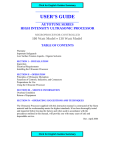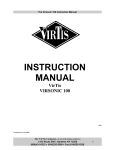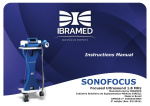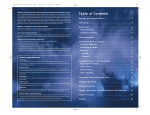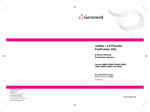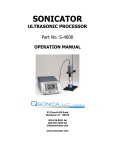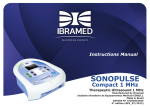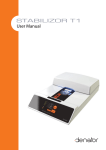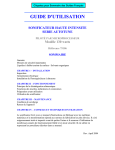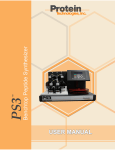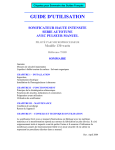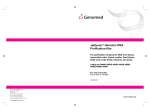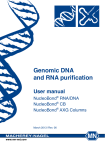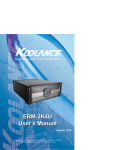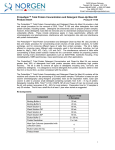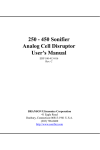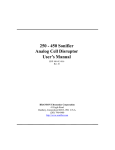Download Serial No. "AC" or higher - Sonics & Materials, Inc.
Transcript
USER’S GUIDE AUTOTUNE SERIES HIGH INTENSITY ULTRASONIC PROCESSOR MICROPROCESSOR CONTROLLED (SERIAL NO. "AC" OR HIGHER) 500 WATT MODEL • 750 WATT MODEL TABLE OF CONTENTS Warranty Important Safeguards and Warnings Specifications Low Surface Tension Liquids – Organic Solvents SECTION I – INSTALLATION Inspection.......................................................................................1 Electrical Requirements ................................................................1 Installing the Ultrasonic Processor ................................................1 SECTION II – OPERATION Principles of Ultrasonic Disruption.................................................2 Functions of Keys, Controls, Indicators, and Connectors.............3 Preparation for Use ........................................................................5 Using the Ultrasonic Processor .....................................................8 SECTION III – SERVICE INFORMATION Cleaning Instructions ...................................................................16 Return of Equipment ....................................................................16 Safety Certification Form .............................................................16 SECTION IV – OPERATING SUGGESTIONS AND TECHNIQUES....................18 The Ultrasonic Processor supplied with this instruction manual is constructed of the finest material and the workmanship meets the highest standards. It has been thoroughly tested and inspected before leaving the factory and when used in accordance with the procedures outlined in this manual, will provide you with many years of safe and dependable service. SONICS & MATERIALS, INC. 53 CHURCH HILL ROAD, NEWTOWN, CT 06470 PHONE: 203.270.4600 REV8-10 WARRANTY Your Ultrasonic Processor is warranted for a period of three years from the date of shipment against defects in material and workmanship under normal use as described in the instruction manual. During the warranty period, the manufacturer will, at its option, as the exclusive remedy, either repair or replace without charge for material and labor, the part(s) which prove to be defective, provided the unit is returned to us properly packed with all transportation charges prepaid. Wear resulting from cavitation erosion is a normal consequence of ultrasonic processing, and is not covered by this warranty. This warranty is in lieu of any other warranties, either express, implied, or statutory. The manufacturer neither assumes nor authorizes any person to assume for it any other obligations or liability in connection with the sale of its products. The manufacturer hereby disclaims any warranty of either merchantability or fitness for a particular purpose. No person or company is authorized to change, modify, or amend the terms of this warranty in any manner whatsoever. Under no circumstances shall the manufacturer be liable to the purchaser or any other person for any incidental or consequential damages or loss of goodwill, production, or profit resulting from any malfunction or failure of its product. This warranty does not apply to equipment that has been subject to unauthorized repair, misuse, abuse, negligence or accident. Equipment which shows evidence of having been used in violation of operating instructions, or which has had the serial number altered or removed, will be ineligible for service under this warranty. All probes are manufactured to exacting specifications and are tuned to vibrate at a specific frequency. Using an out-of-tune probe will cause damage to the equipment and may result in warranty nullification. The manufacturer assumes no responsibility for probes fabricated by another party or for consequential damages resulting from their usage. The aforementioned provisions do not extend the original warranty period of any product that has either been repaired or replaced by the manufacturer. IMPORTANT SAFEGUARDS READ BEFORE INSTALLING OR USING THE EQUIPMENT Your Ultrasonic Processor has been designed with safety in mind. However, no design can completely protect against improper usage, which may result in bodily injury and/or property damage. For your protection and equipment safeguard, observe the following warnings at all times, read the operating instructions carefully before operating the equipment, and retain this instruction manual for future reference. If the Ultrasonic Processor is used in a manner contrary to that specified in this instruction manual, the protection features designed into the unit may be impaired. WARNINGS • Make sure the Ultrasonic Processor is properly grounded via a 3-prong outlet. • High voltage is present in the power supply. DO NOT REMOVE THE COVER. Refer all servicing to qualified service personnel. • Never operate the power supply unless it is connected to the converter. • Never secure anything to the probe, except at the nodal point (point of no activity). • Never touch a vibrating probe. • Air-cool the converter with dry compressed air when operating at high amplitude for prolonged duration. • Hearing protection is highly recommended. It is recommended that a sound abating enclosure or ear protection be used when operating the Ultrasonic Processor. SYMBOLS Caution, Risk of electric shock, Hazardous voltage Caution, Risk of danger. Refer to User Manual. WARNING or CAUTION Where you see the alert symbols and/or WARNING or CAUTION heading, strictly follow the warning instructions to avoid personal injury or equipment failure. SPECIFICATIONS Power Supply Operational Input Voltage 115V~ +/-10% @ 50/60 Hz 230V~ +/-10% @ 50/60 Hz Rated Voltage/Current 115V~, 12A max. for 750 watts, 8A max. for 500 watts 230V~, 7A max. for 750 watts, 5A max. for 500 watts Fuse Rating 115V: F15A 250V for 750 watts, F10A 250V for 500 watts* 230V: F8A 250V for 750 watts, F6.3A 250V for 500 watts* Weight 15 lbs. (6.8 Kg) Dimensions 9.25"H x 7.5"W x 13.5"D 235 mm x 190 mm x 340 mm Output Voltage 1000 V rms (max.) Output Frequency 20 KHz (nom.) or 40 KHz Converter Weight 2 lbs. (900 g) Dimensions 7.25" L x 2.5" Dia. (183 mm x 63.5 mm) Standard ½” Horn Weight 0.75 lbs. (340 g) Dimensions 5.375" L x .5" Dia. (136 mm x 13 mm) Materials Titanium Alloy Ti-6Al-4V Environmental Pollution Degree 2 Installation Category II Operating Limits Temperature: 41 - 104ºF (5 - 40ºC) Relative Humidity 20 - 90% (Non Condensing) Altitude: 6,651 ft. (2000 m) Shipping/Storage Temperature: 35 -120ºF (2 - 49ºC) Relative Humidity 10 - 95% (Non Condensing) Ambient Pressure Extremes: 40,000 ft. (12,192 m) Restriction of Hazardous Substances (ROHS) RoHS Compliant Directive 2002/95/EC Relative humidity Maximum relative humidity 80% for temperatures up to 31ºC decreasing linearly to 50% relative humidity to 40ºC Other For indoor use only *Only use IEC approved Fast acting fuses, Cooper Bussman series S500. CAUTION LOW SURFACE TENSION LIQUIDS – ORGANIC SOLVENTS The probes (solid or with a replaceable tip) are tuned elements that resonate at a specific frequency. If the replaceable tip is removed or isolated from the rest of the probe, the element will no longer resonate at that frequency, and the power supply will fail. Unlike aqueous (water based) solutions which rarely cause problems, solvents and low surface tension liquids are problematic. These liquids penetrate the probe/replaceable tip interface, and force the particulates into the threaded section isolating the tip from the probe. When processing low surface tension liquids ALWAYS use a solid probe. SECTION I – INSTALLATION INSPECTION Prior to installing the Ultrasonic Processor, perform a visual inspection to detect any evidence of damage which might have occurred during shipment. Before disposing of any packaging material, check it carefully for small items. The equipment was thoroughly inspected and carefully packed before leaving our factory. The carrier, upon acceptance of the shipment, assumed responsibility for its safe delivery. Claims for loss or damage sustained in transit must be submitted to the carrier. If damage has occurred, contact your carrier within 48 hours of the delivery date. DO NOT OPERATE DAMAGED EQUIPMENT. Retain all packing materials for future shipment. ELECTRICAL REQUIREMENTS The Ultrasonic Processor requires a fused, single phase 3-terminal grounding type electrical outlet. For power requirements, check the label on the back of the unit. WARNING For your personal safety, do not, under any circumstances, defeat the grounding feature of the power cord by removing the grounding prong. INSTALLING THE ULTRASONIC PROCESSOR The Ultrasonic Processor should be installed in an area that is free from excessive dust, dirt, explosive and corrosive fumes, and extremes of temperature and humidity. If processing flammable liquids, use an approved fume hood and do not place the power supply in the fume hood. When positioning the unit, be sure to leave adequate space behind the unit so that all connections can be easily disconnected. 1 SECTION II – OPERATION PRINCIPLES OF ULTRASONIC DISRUPTION The ultrasonic power supply converts 50/60 Hz line voltage to high frequency electrical energy. This high frequency electrical energy is transmitted to the piezoelectric transducer within the converter, where it is changed to mechanical vibrations. The vibrations from the converter are intensified by the probe, creating pressure waves in the liquid. This action forms millions of microscopic bubbles (cavities) which expand during the negative pressure excursion, and implode violently during the positive excursion. This phenomenon, referred to as cavitation, creates millions of shock waves in the liquid, as well as elevated pressures and temperatures at the implosion sites. Although the cavitational collapse lasts but a few microseconds and the amount of energy released by each individual bubble is minimal, the cumulative effect causes extremely high levels of energy to be released into the liquid. The larger the probe tip, the larger the volume that can be processed but at a lesser intensity. For information regarding the processing capability of each probe, consult the tables below. TAPERED MICROTIPS STEPPED MICROTIP TIP DIAMETER 1/8" (3mm) 3/16" (5mm) 1/4" (6.5mm) 1/8" (3mm) INTENSITY ultra high very high high very high VOLUME (batch) 1-10ml 3-20ml 5-50ml 250ul-10ml STANDARD PROBES TIP DIAMETER 1/2" (13mm) 3/4" (19mm) 1" (25mm) INTENSITY high medium low VOLUME (batch) 10-250ml 25-500ml 500-1000ml HIGH GAIN PROBES TIP DIAMETER 3/4" (19mm) 1" (25mm) INTENSITY high medium VOLUME (batch) 25-500ml 500-1000ml 2 FUNCTIONS OF KEYS, CONTROLS, INDICATORS, AND CONNECTORS FRONT PANEL Displays prompts and the following control parameters: • Amplitude selected • Output power delivered to the probe in watts, and as percentage of the total power Screen • Selected duration of processing • Actual processing time • Elapsed time • Set and read temperature • Pulse duration • Accumulated amount of energy in Joules delivered to the probe. 0 – 9 key CLEAR key Input digits. Clears preceding entry. ENTER/REVIEW key Enters data into the program, and selects various parameters, for display on the LCD screen. TIMER key Used with the numeric keys to set the duration of ultrasonic application – from 1 second to 9 hours, 59 minutes, 59 seconds. PULSER key START/STOP key Used with the numeric keys to set the pulse mode. The ON cycle and OFF cycle can be set independently from 1 second to 59 seconds. Red indicator lights when pulser is in the OFF portion of the cycle. Starts or stops the ultrasonics. In the STOP mode the red indicator goes off. PAUSE key Suspends operation. Red indicator lights when the processing cycle is interrupted. AMPL key Controls the amplitude of vibration at the probe tip. I key Switches the main power on. O key Switches the main power off. ▲▼ key Used with the AMPL key when the unit is on stand-by to set the amplitude of vibration at the probe tip. Also used to increase or decrease the amplitude in small increments while the unit is running. To accomplish this task, depress the AMPL key to display the percentage of amplitude previously selected, then depress the ▲ or ▼ key as required. 3 FUNCTIONS OF KEYS, CONTROLS, INDICATORS, AND CONNECTORS (cont.) REAR PANEL 9-pin D-sub connector Connects to external actuation device, and enable power and frequency monitoring Footswitch jack Connects to the footswitch cable. Coax connector Connects to the converter. Power module Connects to the electrical line cord and encases the fuse(s). Temperature probe jack Connects to the optional temperature probe. 9-PIN D-SUB CONNECTOR Pin No. Description 1 Not connected 2 Not connected 3 Not connected 4 Enables connection to a frequency counter. 5 Enables connection to an external power monitor (5 mv = 1 watt) 6 Ground 7 Energizes the ultrasonics when connected to ground. 8 and 9 Enables the intensity to be remotely adjusted using an external 10k potentiometer. See below to pin 9 10K to pin 8 to pin 6 NOTE To vary the intensity remotely using a variable DC power supply (0-5V) instead of a 10 K potentiometer, connect positive to pin 8 and negative to pin 6. 4 PREPARATION FOR USE CAUTION Do not operate an Ultrasonic Processor that has been in a very cold or hot environment for a prolonged period of time. Wait until it has reached room temperature 1. Connect the Power Cord to the receptacle on the rear of the processor. 2 Plug the Power Cord into a grounded electrical outlet. If the unit is already on, switch the unit off by depressing the O key. 3. If the optional footswitch is used, insert the footswitch plug into the jack located on the rear panel. Make sure that the plug is inserted all the way in. 4. Screw the booster into the converter and secure forcefully with the spanner wrenches provided. CAUTION Never place a washer between the converter, booster or probe. Never apply grease to the mating surfaces or threads of the converter, booster or probe. 5. Using the spanner wrenches provided, forcefully secure the booster to the probe. 6. Mount the converter/probe assembly in a stand. Secure the clamp to the converter housing only. Do not secure the clamp to the probe. 7. Connect the converter cable to the power supply. 8. Connect either one of the air fittings on top of the converter to a source of dry compressed air. NOTE Should it become necessary to remove a probe, use the wrenches supplied. If the probe has been attached to the converter for a long period of time it might be necessary to use a vise. Be sure the vise has soft jaws or other means to prevent scratching. Secure the wide diameter portion of the probe in the jaws of the vise. Never grip the converter in the vise. Using a wrench, twist the converter off the probe. A tap of a hammer may be applied to the end of the wrench. Never attempt to remove the probe by twisting the converter housing, as this may damage the electrical connections within the housing. 5 6 No 1 2 3 4 5 6 7 8 9 10 11 12 13 14 15 16 17 18 19 20 Order Number DESCRIPTION Converter Model CV33 Four element coupler Stepped top(s) 1/8” (3mm) Booster Probe ½” (13mm) solid Probe ½” (13mm) with threaded end and replaceable tip Probe ¾” (19mm) solid Probe ¾” (19mm) with threaded end and replaceable tip Probe 1” (25mm) solid Probe 1” (25mm) with threaded end and replaceable tip Replaceable tip ½” (13mm) Replaceable tip ¾” (19mm) Replaceable tip 1” (25mm) Coupler Stepped microtip 1/8” (3mm) Probe ½” (13mm) with threaded end and replaceable tip Tapered microtip 1/8” (3mm) Tapered microtip 3/16” (5mm) Tapered microtip ¼” (6mm) Probe – solid or with threaded end and replaceable tip – same as 5 Replaceable tip – same as 6 Extender ½” (13mm) Extender ¾” (19mm) Extender 1” (25mm) Full wave extender ¾” (19mm) – 10” (254mm) long Full wave extender 1” (25mm) – 10” (254mm) long High gain probe ¾” (19mm) – solid High gain probe ¾” (19mm) with threaded and replaceable tip High gain probe 1” (25mm) – solid High gain probe 1” (25mm) with threaded and replaceable tip Replaceable tip ¾” (19mm) or 1” (25mm) – same as 6 Full wave probe ½” (13mm) solid – 10” (254mm) long Full wave probe ½” (13mm) – 10” (254mm) long with threaded and replaceable tip Aluminum coupler ¾” (19mm) solid probe Cup horn 1 ½” (38mm) Cup horn 2 ½” (64mm) Cup horn 3” (76mm) CV00033 630-0558 630-0535 BHNVCGD 630-0219 630-0220 630-0208 630-0207 630-0209 630-0210 630-0406 630-0407 630-0408 630-0421 630-0422 630-0220 630-0418 630-0419 630-0420 630-0410 630-0409 630-0444 630-0518 630-0519 630-0306 630-0305 630-0310 630-0311 630-0217 630-0218 630-0562 630-0208 630-0503 630-0431 630-0496 CAUTION Do not use tapered microtip with coupler. Do not use stepped tip without a coupler. Do not use probes with threaded end and replaceable tip, when working with low surface tension liquids. 7 USING THE ULTRASONIC PROCESSOR The speed control on an automobile, can, to a certain extent, be compared to an Ultrasonic Processor. The speed control is designed to maintain the vehicles rate of travel constant. As the terrain changes, so do the power requirements. The speed control senses these requirements, and automatically adjusts the amount of power delivered by the engine in order to compensate for these ever changing conditions. The greater the terrain rate of incline and greater the resistance to the movement of the vehicle, the greater the amount of power that will be delivered by the engine to overcome that resistance. The Ultrasonic Processor is designed to deliver constant amplitude. As the resistance to the movement of the probe increases, additional power will be delivered by the power supply to ensure that the excursion at the probe tip remains constant. Using a more powerful power supply will not deliver more power into the liquid. Rather, it is the resistance to the movement of the probe that determines how much power will be delivered into the sample. The AMPLITUDE control allows the ultrasonic vibrations at the probe tip to be set to any desired level. Although the degree of cavitation required to process the sample can readily be determined by visual observation, the amount of power required cannot be predetermined. A sensing network continuously monitors the output requirements, and automatically adjusts the power to maintain the amplitude at the preselected level. The greater the resistance to the movement of the probe due to higher viscosity, deeper immersion of the probe into the sample, larger probe diameter or higher pressure, the greater the amount of power that will be delivered to the probe. Setting the amplitude to 100% will not cause the maximum power that the power supply is capable of delivering, to be delivered to the sample. For example, with the 500 watt Ultrasonic Processor, the maximum power that the power supply is capable of delivering will only be delivered when the resistance to the movement of the probe is high enough to draw 500 watts. CAUTION When working with a microtip, do not operate the equipment beyond the maximum amplitude limits listed below. I g n or i n g t h is ca u t ion w i ll ca u s e t h e m ic r ot ip t o f r a ct u r e. Tapered microtip: Stepped Microtip: Size 1/8” (3 mm) 3/16” (5 mm) 1/4” (6 mm) Maximum Amplitude 40% 65% 75% 5/64” (2 mm) 1/8” (3 mm) 1/4” (6 mm) 40% 40% 40% 8 CAUTION Do not operate the power supply unless it is connected to the converter. Press the I key. The screen will display the power rating and the frequency of the Ultrasonic Processor, and the following control parameters. TIME __:__:__ PULSE _ _ _ _ TEMP __ __°C AMPL __ __% AMPLITUDE: The amplitude is the only parameter that must be set in order for the Ultrasonic Processor to be operational. The other control parameters – Time and Pulse, do not have to be set for continuous operation. AMPL. displays the percentage of amplitude that was previously selected. Press the AMPL key and the ▲ or ▼ key for a reading of 40%, then depress the ENTER/REVIEW key. The screen will display: TIME __:__:__ PULSE _ _ _ _ TEMP __ __°C AMPL 40% The Ultrasonic Processor is now ready for continuous operation. To energize the equipment, press the START key or the footswitch. To de-energize the equipment, press the STOP key or release the footswitch. If the Time or Pulse* functions must be used, refer to the appropriate paragraph(s) below. To increase or decrease the amplitude in small increments when the equipment is on, depress the AMPL key to display the percentage of amplitude that was previously selected, then depress the ▲ or ▼ key, as required. NOTE Any combination of functions can be selected in any order. To clear an erroneous entry press the CLEAR key. 9 NOTE If the START key is pressed and the time limit has not been set, processing will remain uninterrupted until the STOP key is depressed. If the START key is pressed and the time limit has been set, processing will remain uninterrupted until the set time limit expires, or the STOP key is pressed – whichever occurs first. If a footswitch is use, and the time limit has not been set, processing will remain uninterrupted as long as the footswitch is depressed. If a footswitch is used, and the time limit has been set, processing will remain uninterrupted until the time limit expires or the footswitch is released – whichever occurs first. The START key and footswitch are mutually exclusive. If the process is initiated by the START key, the footswitch becomes inoperative. If the process is initiated by the footswitch, the STOP key becomes inoperative. 1. Using the fittings on top of the converter, circulate dry compressed air through the converter to cool the converter. 2. Immerse the probe into the liquid. Always immerse the probe deep enough below the surface of the sample to inhibit aerosoling or foaming. Foaming substantially reduces cavitation. Processing at a lower power setting without foam is more effective than processing at a higher power setting with foam. Decreasing the power, increasing processing time and lowering the temperature of the sample will usually prevent aerosoling and foaming. Do not use any antifoaming agents or surfactants. NOTE The probe is tuned to vibrate at a specific frequency. If the resonant frequency of the probe has changed, due to cavitation erosion or fracturing, a minimum reading will not be obtained. If an overload condition exits, or if minimum reading cannot be obtained (less than 20%) when the flow cell is empty or when using a probe without the flow cell and the probe is in air (out of the sample), check the instrument without the probe to determine if the probe has failed or is out of tune. If minimum reading is obtained using the converter without the probe, the probe is defective and should be changed. A loose probe will usually generate a loud piercing sound. Refer to Section III if an overload condition exists. 10 3. Depress the START key. CAUTION When working with a ¾" (19 mm) probe or extender, do not set the amplitude above 70. With a 1" (25 mm) probe, do not operate continuously with the amplitude set above 90. 4. Using the ▲ or ▼ keys, increase or decrease the amplitude as required. TIMER: In the pulsed mode the processing time will be different from the elapsed time because the processing time function monitors and controls only the ON portion of the duty cycle. For example, for 1 hour processing time, the elapsed time will be 2 hours if the ON and OFF cycle are set for 1 second. To set the processing time, press the TIMER key. The screen will display: Time Setting Hrs:__ Min:_ _ Sec:_ _ Using the numeric keys, set the processing time as required: Time Setting Hrs: 5 Min: 30 Sec: 25 Press the ENTER/REVIEW key. The screen will display: TIME 5:30:25 PULSE _ _ _ _ 11 TEMP __ __°C AMPL 40% PULSER: By inhibiting heat build-up in the sample, the pulse function enables safe treatment of temperature sensitive samples at high intensity. In addition, pulsing enhances processing by allowing the material to settle back under the probe after each burst. The ON and OFF pulse duration can be set independently from 1 second to 59 seconds. During the OFF portion of the cycle, the red indicator on the PULSER key will illuminate. If the OFF portion of the cycle exceeds three seconds, a cautionary message – CAUTION – PROBE ON STANDBY – will warn the operator against touching the ultrasonic probe. To set the pulser, press the PULSER key. Pulse on __.__sec Pulse off __.__sec The screen will display: Using the numeric keys set the ON portion of the cycle, then press the ENTER/REVIEW key. Pulse on 01 sec Pulse off __.__sec The screen will display: e.g. Using the numeric keys set the OFF portion of the cycle. The screen will display: e.g. Pulse on 01 sec Pulse off 01 sec Press the ENTER/REVIEW key. The screen will display: TIME 5:30:25 PULSE 01 01 On Cycle 12 Off Cycle AMPL 40% REVIEW: The REVIEW function provides a “window” on the process by displaying various operating parameters without process interruption. Pressing the ENTER/REVIEW key repeatedly during processing will consecutively display the following information. a) Selected amplitude: e.g., Amplitude 40% b) Set processing time and elapsed processing time: e.g., Set 5:30:25 Time 0:57:03 c) Selected pulsing cycle, and actual pulsing cycle: e.g., Pulse 01 / 01 d) Amount of power in watts, and accumulated amount of energy in JOULES delivered to the probe: e.g., 20 watts 0000000 Joules* e) Elapsed time since processing was initiated: e.g., Elapsed time 1:27:33 NOTE The amount of energy displayed will be only for one cycle. Initiating a new cycle will reset the display to zero. *The number of Joules displayed is dependent on the watts being drawn and the processing time. 13 IMPORTANT Proper care of the probe is essential for dependable operation. The intense cavitation will, after a long period of time, cause the tip to erode, and the power output to decrease without showing up on the wattmeter. The smoother and shinier the tip, the more power will be transmitted into the sample. Any erosion of the probe tip will increase the rate of future erosion. For that reason it is recommended that after every 5 or 6 hours of use the tip be examined, and if necessary, polished with emery cloth or an abrasive wheel, or machined in a lathe. Since the probe is tuned to vibrate at a specific frequency, it is most important that only the contaminated surface be removed. This procedure can be repeated as long as the power monitor reading is less than 20% with the probe out of the sample, when the AMPLITUDE control is set at 100. If the reading exceeds 20%, the probe or replaceable tip should be replaced with a new one. 14 SECTION III – SERVICE INFORMATION Your Ultrasonic Processor was designed to provide you with years of safe and dependable service. Nevertheless, because of component failure or improper usage, the possibility does exist that it might not perform, as it should, shut down due to an overload condition or that it will stop working all together. The most probable causes for malfunction are listed below and should be investigated. The unit was plugged into an electrical outlet that provides a different voltage from the one required. See Electrical Requirements. The probe or booster is not secured properly. A fuse(s) has failed. 1. Set the AMPLITUDE to 50, and press the I and the START/STOP key. With the flow cell empty of any liquid, or the probe in air (out of sample), the wattmeter should read below 10 watts. If the reading exceeds 10 watts, press the START/STOP key, and disconnect the probe from the booster. 2. Press the START/STOP key to restart the equipment. If the wattmeter reads below 20 watts, the probe has failed or is out of tune due to excessive erosion, and should be replaced. If the wattmeter reads above 20 watts, either the converter, booster, or power supply has failed and the Ultrasonic Processor should be returned for repair. 3. If the Ultrasonic Processor stops working due to an overload condition as indicated on the display, press the O key, investigate and remedy the problem, then press the I key to restart the equipment. 15 CLEANING INSTRUCTIONS The generator and converter may be cleaned using a solvent-free cleaning solution (i.e. glass cleaner). Horns and probes should be cleaned using isopropyl alcohol. Horns are made from titanium and can be autoclaved. RETURN OF EQUIPMENT It is suggested that if a unit is in need of repair, it should be sent back to the factory. In order to receive prompt service; always contact the factory before returning any equipment. Include date of purchase, model number and serial number. For equipment not covered by the warranty, a purchase order should be forwarded to avoid unnecessary delay. Care should be exercised to provide adequate packing to insure against possible damage in shipment. The equipment should be sent to the “Service Department” with all transportation charges prepaid and return of shipment indicated. Please obtain a Return Authorization Number (RA#) prior to returning the instrument. SAFETY CERTIFICATION FORM* Federal law prohibits the transfer of equipment or products contaminated with radiological, biological or chemical waste residue. Sonics requires that each customer certify one of the statements on page 19. Prior to returning any equipment, please make a copy of the form on page 19, fill in the form and send it back with the equipment being returned. *This form must accompany any equipment that is being returned for repair. 16 SONICS SAFETY CERTIFICATION FORM Items being returned: Please check only one item below: ___ The equipment was never used or exposed to any radiological, biological or chemical agents and is safe to handle, use or dispose of. ___ The equipment was used but not in conjunction with or exposed to any radiological, geological or chemical agents and is safe to handle, use, or dispose of. ___The equipment was used in conjunction with or exposed to radiological, biological, or chemical agents and has been decontaminated, rendering it safer for handling, use, or disposal. Authorization By accepting authorization to return the equipment listed above, the undersigned assumes all responsibility and liability for radiological, biological and chemical decontamination. Sonics reserves the right to refuse delivery of the equipment without necessary documentation or where we determine they have not been properly decontaminated. Sonics reserves the right to bill the customer for any and all costs associated with the decontamination and/or disposal of the equipment we determine was not properly decontaminated. In the event the equipment has been exposed to radiological contamination, the signature of the Radioactive Safety Officer is required. Print name: ___________________________________ RA # ___________________ Signature: ____________________________________ 17 Date: __________________ SECTION IV OPERATING SUGGESTIONS AND TECHNIQUES DISRUPTING CELLS The disruption of cells is an important method in the field of proteomics and in the isolation and preparation of intracellular products. Isolation of subcellular fractions and concentration of proteins allow for more efficient identification and study of proteins of interest. From research levels through to production, many areas of biotechnology, particularly recombinant technology, necessitate the use of ultrasonics for cell disruption. Cell disruption focuses on obtaining the desired product from within the cell, and it is the cell wall that must be disrupted to allow access to the contents of the cell. All cells have a plasma membrane, a protein-lipid bilayer that forms a barrier separating cell contents from the extracellular environment. Lipids constituting the plasma membrane are amphipathic, having hydrophilic and hydrophobic moieties that associates spontaneously to form a closed bimolecular sheet. Membrane proteins are embedded in the lipid bilayer, held in place by one or more domains spanning the hydrophobic core. In addition, peripheral proteins bind the inner or outer surface of the bilayer through interactions with integral membrane protein or with polar lipid head groups. The nature of the lipid and protein content varies with cell type. In animal cells, the plasma membrane is the only barrier separating cell contents from the environment, but in plants the plasma membrane is also surrounded by a rigid cell wall. Plant cell walls consist of multiple layers of cellulose. These types of extracellular barrier confer shape and rigidity to the cells. Plant cell walls are particularly tough, making them very difficult to disrupt mechanically or chemically. The lack of an extracellular wall in animal cells make them relatively easy to lyse. Soft, fresh plant tissue can often be disrupted by sonicating in a lysis buffer. Other plant tissues, like pine needles, need to be ground dry, without liquid nitrogen. Some hard, woody plant materials require freezing and grinding in liquid nitrogen prior to being ultrasonically processed. Plant cell suspension cultures and calluses can be lysed by sonication in a lysis buffer for 30 seconds to 2 minutes. The diversity of plants and plant tissue make it impossible to give a single recommendation for all samples. However, one should be aware that most plant tissues typically contain polysaccharides and polyphenols that can coprecipitate with RNA and inhibit downstream assays. Treating a plant tissue lysate with polyvinylpyrrolidone (PVP) will precipitate such problematic components from the lysate before the actual RNA isolation is carried out. 18 Single-cell organisms (micro-organisms) consist of a semipermeable, tough, rigid outer cell wall surrounding the protoplasmic membrane and cytoplasm. The cytoplasm is made up of nucleic acid, protein, carbohydrates, lipids, enzymes, inorganic ions, vitamins, pigments, inclusion bodies, and about 80% water. In order to isolate and extract any of these substances from inside the cell, it is necessary to break the cell wall and protoplasmic membrane. In some cases the cell may excrete the desired substance without assistance, but in most cases, the cells must be lysed in order for these intracellular substances to be released. Breaking cell membranes and releasing the contents present significant challenges. The process must be fast and thorough to maximize the protein yield. Because the energy applied must be great enough to break the cell membranes or walls, yet gentle enough to avoid physically or chemically damaging cell content, the Vibra-Cell with its variable intensity capability is ideally suited for this application. Microorganisms differ greatly in their sensitivity to ultrasonic disintegration. For example, the most readily disintegrated are the rod-like forms (bacilli), while the spherical organisms (cocci) are much more resistant. The group Mycobacteria, to which the tuberculosis organism belongs, is particularly difficult to disrupt. Yeast, gram-positive bacteria, and to a lesser extent, gram-negative bacteria have considerably harder cell walls in comparison to animal cells, and require relatively high power for cell disruption. Bacteria are extremely diverse; therefore, it is difficult to make one recommendation for all bacteria. Ultrasonic processing will lyse most Gram positive and Gram negative bacteria, including mycobacteria. Typically, glass beads and lysis solutions are added to a bacterial cell pellet and the sample is sonicated for a few minutes. It is possible to lyse some Gram negative bacteria by sonication in lysis solution alone. Bacteria cell walls can be digested with lysozyme to form spheroplasts. Gram positive bacteria usually require more rigorous digestion (increased incubation time, increased incubation temperature, etc.) than Gram negative organisms. The spheroplasts are then easily lysed in a GITC lysis buffer with ultrasonics. Gram negative bacteria typically require 10 to 15 minutes of processing, while staphylococcus requires 20 to 30 minutes. The level of intensity that should be used is application dependent. For example high intensity might be recommended for the break up of cells, but should never be used when the release of intracellular components might be objectionable e.g., Organelle isolation. 19 The ability to control the amplitude at the probe tip is a prerequisite for process optimization. And because each application requires its own set of processing parameters, due to variation in volume and composition, the optimum amplitude can only be determined empirically. When processing a new sample, it is recommended that the amplitude be set first at 50% (30% with a microtip) and then increased of decreased as required. Prior to sonication, cells can be treated with various agents to aid the disruption process. Lysis can be promoted by suspending cells in a hypotonic buffer, which causes them to swell and burst more readily by physical shearing. Lysozyme can be used to digest the polysaccharide component of yeast and bacterial cell walls. Alternatively, processing can be expedited by treating tough cells with glass beads to facilitate the crushing of cell walls. This treatment is commonly used with yeast cells. Viscosity of a sample typically increases during lysis due to the release of nucleic acid material. DNase can be added to samples (25-50 µg/ml) to reduce this problem. Nuclease treatment is not required for sonicated material because sonication shears chromosomes. Because proteolysis can be a problem whenever cells are manipulated; it is advisable to add protease inhibitors to samples undergoing lysis. NOTE: All living organisms contain proteolytic enzymes (proteases and peptidases). Proteases are required for a variety of cellular functions, such as cellular repair or the digestion of extracellular material. In whole cells, protease activity is tightly regulated by compartmentalization or inhibitors to prevent damage to cellular proteins. Cell lysis disturbs this regulation and proteolytic degradation of the sample becomes a concern. Therefore, addition of protease inhibitors to cell lysis buffers is often required. Protease inhibitors are biological or chemical compounds that functions by reversibly or irreversibly binding to the protease. Proteases generally belong to one of four evolutionarily distinct enzyme families based on the functional groups involved in cleavage of the peptide bond. Therefore, several different types of inhibitors are generally required to protect proteins from proteolysis during extraction and purification. Cellular disruption is the first step in RNA isolation and one of the most critical steps affecting yield and quality of the isolated RNA. Typically, cell disruption needs to be fast and thorough. Slow disruption, for example placing cells or tissue in guanidinium isothiocyanate (GITC) lysis solution without any additional physical shearing, may result in RNA degradation by endogenous RNase released internally, yet still inaccessible to the protein denaturant, GITC. This is especially a concern when working with tissues high in endogenous RNase such as spleen and pancreas. Incomplete disruption may also result in decreased yield because some of the RNA in 20 the sample remains trapped in intact cells and, therefore, is unavailable for subsequent purification. For most samples, thorough disruption can be monitored by close inspection of lysate after disruption. There should be no visible particulates, except when disrupting materials containing hard, non-cellular components, such as connective tissue or bone. When processing difficult cells, pretreatment with an enzyme to “weaken” the cell walls is beneficial. Lysozyme, byaluronidase, glycosidase, glucalase, lyticase, zymolase and lysostaphin digestion are among the enzymatic methods frequently used with yeast. Lysozyme, zymolase and lysostaphin digestion are among the enzymatic methods frequently used with bacteria and yeast to dissolve a coat, capsule, capsid or other structure not easily sheared by ultrasonics. Enzymatic treatment is usually followed by sonication in a GITC lysis buffer. Collogenase may be used with collogen, lysostaphin with staphylococcus, and trypsin hyaluronidase with liver and kidney. Yeast can be extremely difficult to disrupt. To process yeast sonicate in a tube containing the sample, guanidinium-based lysis buffer and small glass beads (0.5 – 1 mm). Enzymatic pretreatment as outlined above is strongly recommended. To disrupt filamentous fungi, scrape the mycelial mat into a cold mortar, add liquid nitrogen, grind to a fine powder with a pestle, then sonicate in lysis buffer to solubilize completely. As fungi may also be rich in polysaccharides, pretreatment with polyvinylpyrrolidone (PVP) may be beneficial. Disruption of cells found in soil and sediments is accomplished by 1) isolating the bacterial cells from the material prior to the RNA isolation procedure. This is accomplished by homogenization of wet soil in a mechanical blender followed by a slow speed to pellet the bacteria cells. From this point, cells can be lysed as described above for bacteria, or 2) isolating RNA from the soil or sediment directly. For example, adding soil to a diatomaceous earth and lysis buffer, and then sonicating. The sample is then centrifuged to remove solid debris. Cultured cells are relatively easy to disrupt. Cells grown in suspension are collected by centrifugation, rinsed to remove culture medium, and then lysed by sonicating in GITC lysis buffer. Placing the flask or plate on ice while washing and lysing the cells will further protect the RNA from endogenous Rnases released during the disruption process. 21 Detergent cell lysis is sometimes used in conjunction with ultrasonic processing to facilitate disruption. Detergents break the lipid barrier surrounding cells by solubilizing proteins and disrupting lipid:lipid, protein:protein and protein:lipid interactions. Detergents, like lipids, self-associate and bind to hydrophobic surfaces. They are composed of a polar hydrophilic head group and a nonpolar hydrophobic tail and are categorized by the nature of the head group as either ionic (cationic or anionic), nonionic or zwitterionic. Their behavior depends on the properties of the head group and tail. NOTE: When working with detergents, do not use a probe with a replaceable tip. Use a solid probe instead. Unfortunately, there is no standard protocol available for selecting a detergent to use for membrane lysis, the ideal detergent will depend on the intended application. In general, nonionic and zwitterionic detergents are milder and less denaturing than ionic detergents and are used to solubilize membrane proteins when it is critical to maintain protein function and/or retain native protein:protein interactions for enzyme assays or immunoassays. Zwitterionic detergents and nonionic detergents are commonly used for these purposes. In contrast, ionic detergents are strong solubilizing agents and tend to denature proteins, thereby destroying protein activity and function. There are a few commonly used ionic detergents that are only mildly denaturing, including sodium cholate and sodium deoxycholate. The choice of detergent for cell lysis also depends on sample type. Animal cells, bacteria and yeast all have differing requirements for optimal lysis due to the presence of absence of a cell wall. Because of the dense and complex nature of animal tissues, they require both detergent and sonication. In addition to the choice of detergent, other important considerations for optimal cell lysis include the buffer, pH, salt concentration and temperature. Consideration should be given to the compatibility of the chosen detergent with downstream applications. For example, if the detergent used for lysis must be removed, then a dialyzable detergent should be selected. If pretreatment with enzymes or detergents cannot be used, the freeze / thaw method should be considered. The freeze / thaw method is commonly used to lyse bacterial and mammalian cells. The technique involves freezing a cell suspension for 10 minutes in a dry ice and isopropanol bath and then thawing the material at room temperature immediately prior to ultrasonic processing. The freeze / thaw cycle should be repeated three times prior to being subjected to the ultrasonics. This method of lysis causes cells to swell and ultimately break as ice crystals form during the freezing process and then contract during thawing. This pretreatment has been 22 shown to effectively release recombinant proteins located in the cytoplasm of bacteria and is recommended when lysing mammalian cells. However, this method for lysis is not recommended when working with nitrilases as it has been noticed that purified nitrilases suffer structural damages upon freezing. Most animal tissues can be processed fresh (unfrozen). However, it is important to keep them cold and to process them quickly (within 30 minutes) after dissection. When disrupting fresh tissue, the cells need to be sheared immediately at the time the GITC lysis solution is added. This can be done by dispensing the lysing solution in the tube, adding the tissue and immediately sonicating. Samples should never be left sitting in lysis solution, undisrupted. Hard tissues should be first treated in a blender or a mechanical homogenizer. Animal tissues that have been frozen after collection should be disrupted by grinding in liquid nitrogen with a mortar and pestle. During this process, it is important that the equipment and tissue remain at cryogenic temperatures. The tissue should be dry and powdery after grinding. Grinding should be followed by sonication in a GITC lysis buffer. Processing frozen tissue in this way is cumbersome and time consuming, but effective. Ultrasonic processing will typically cause the temperature of the sample to increase especially with small volumes. Since high temperatures inhibit cavitation, the sample temperature should be kept as low as possible - preferably just above its freezing point. This can be accomplished by pulsing the ultrasonics on and off while keeping the sample vessel immersed in an ice bath. While processing the sample occasionally touch the vessel to ensure that the sample is relatively cool. Increasing hydrostatic pressure (typically 15-60 psi) and viscosity can enhance cell disruption. For microorganisms, the addition of glass beads in the 0.5 to 1mm size range promotes cell disruption. Beads are almost a prerequisite when working with spores and yeast. A good ratio is one volume of beads to two volumes of liquid. Glass beads are available from: Cole-Parmer Instruments 625 East Bunker Court Vernon Hills, Illinois 60061 USA Phone: 1-800-323-4340 Fax: 847-247-2929 Email: [email protected] Fisher Bioblock Scientific Parc d’innovation – BP 50111 F-67403 illkirch cedex France Phone: 03 88 67 14 14 Fax: 03 88 67 11 68 Email: [email protected] 23 When processing a sample with ultrasonics, always immerse the probe deep enough below the surface of the sample to inhibit aerosoling or foaming, foaming substantially reduces cavitation. Processing at a lower power setting without foam is much more effective than processing at a higher power setting with foam. Decreasing the power, increasing processing time and lowering the temperature of the sample will usually prevent aerosoling and foaming. Do not use any antifoaming agents or surfactants. During cavitation, free radicals are formed which, if they are allowed to accumulate, can greatly affect the biological integrity of the sample by reacting with proteins, polysaccharides, or nucleic acids. Although during short periods of processing their formation is not normally considered a problem; for longer durations, the addition of free radical scavengers such as, carbon dioxide, N2O, cysteine, reduced glutahione, dithiothreitol or other SH compounds, might be beneficial. Saturating the sample with a protective atmosphere of helium or nitrogen gas, or dropping a small pellet of dry ice in the sample, will also inhibit free radical formation. Whereas it is true that gas is required for effective cellular disruption, it is not necessary that the vapor phase be oxygen or air since any gas except carbon dioxide will work just as well. Following ultrasonic processing, the cell debris can be centrifuged at 15,000 rpm for 10 minutes. Since the greatest concentration of energy is beneath the probe, it is imperative that the sample be kept as close to the tip as possible, liquids are easily processed because the free moving cells circulate repeatedly below the probe. Solid materials however have a tendency to be repelled by the ultrasonic, and should be processed in a vessel large enough to accommodate the probe, yet small enough to restrict sample movement. For small samples, conical shaped test tubes are recommended. Although plastic tubes work well, glass and stainless steel tubes usually work better than plastic ones. Make sure that the probe is not touching the bottom of the vessel. Allowing the probe to contact the vessel will decrease the power output, and cause minute grey glass particles to migrate into the sample. Although these glass particles will not adversely affect the chemical composition of the sample, they will form a thin grey layer on centrifuging. If the probe has to come in contact with a solid sample, use a standard 20mm (3/4”) diameter stainless steel centrifuge tube cut to 70mm (3") length. Do not use a glass tube. Microtips must never come in contact with anything but the liquid, because the stress resulting at the point of contact with a hard surface will cause the microtip to fracture. Although larger probes will not fracture if they come in contact with a glass vessel, they may cause the vessel to fracture. 24 Before each application, place the tip in 100% ethanol and energize the power supply for a few seconds to remove any residual substances. If still concerned about contamination from previous use, clean the probe with a disinfectant such as 20% Virkon solution and rinse with distilled water. Probes are autoclavable. To inhibit sample loss in test tube due to sticking, siliconize the test tube as follows: Wash and dry the test tube thoroughly, coat with silicone, then air dry. “Sigmacote” manufactured by Sigma Chemical Co., 3050 Spruce Street, St. Louis, Missouri 63103, USA, phone (314) 771-5765, is ideally suited for that purpose. High viscosity and concentration are problematic. 2,000 cps and 15% concentration by weight are maximum limits. Ultrasonic processing propagates sound waves through the sample. If the sample is so dense that it will not pour or circulate easily it will absorb the sound waves, and be too thick for ultrasonic processing. Use the Cup Horn for processing pathogenic, radioactive, and biohazardous materials in complete isolation without probe intrusion. Because plastic tubes have a tendency to absorb vibrations, it is preferable to contain the sample in a stainless steel tubes or glass tubes when working with a cup horn. To expedite processing, add glass beads to the sample. If desired, crushed ice can also be added to the water inside the cup horn, in order to optimize cooling. Processing samples in a Cup Horn will usually take 4 times longer than processing with direct probe intrusion. Various methods can be implemented to measure the efficiency of ultrasonic disruption. Typically, counting the cells using a microscope is a satisfactory method. However, for greater accuracy, a protein assay should be used. This procedure is widely recognized as a good method for measuring cell disruption by taking into account the amount of protein released after disruption. The disrupted cells are then tested and checked against this number for percentage breakage. There are several types of protein assays. The most common is the Folin Reaction (Lowry Assay) method, as it is comparatively simple and provides consistent results. This colorimetric method has a sensitivity to protein of around 8 µg / mL in the assay solution. The assay turns blue in the presence of proteins due to the reaction of copper ions in the alkaline solution with protein and the reduction of phosphomolybdatephosphotungstic acid in the Folin reagent by aromatic amino acids in the treated protein. 25 Fractional protein release, Rp, is calculated using the following equation and multiplying the result by 100: Rp = Cf – Cb Ct – Cb Cf = Free protein Ct = total protein Cb = Background protein This gives the actual disruption percentage, taking into account the background levels of protein before disruption. 26
































